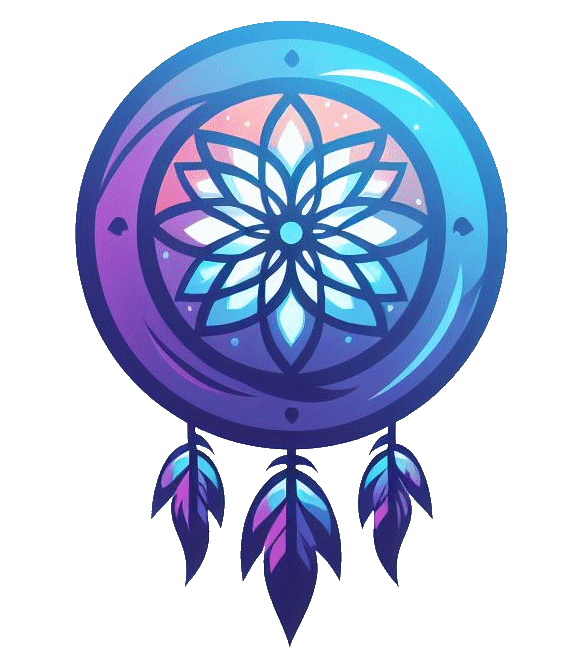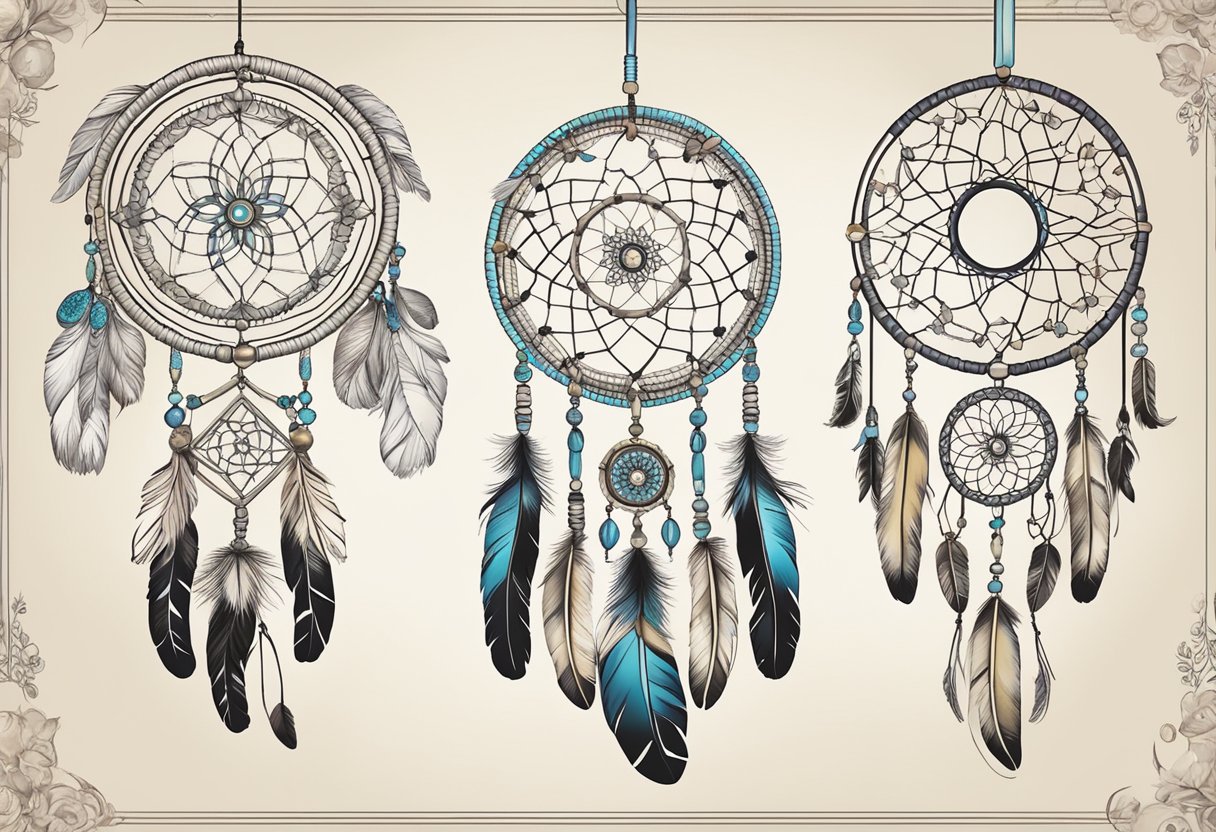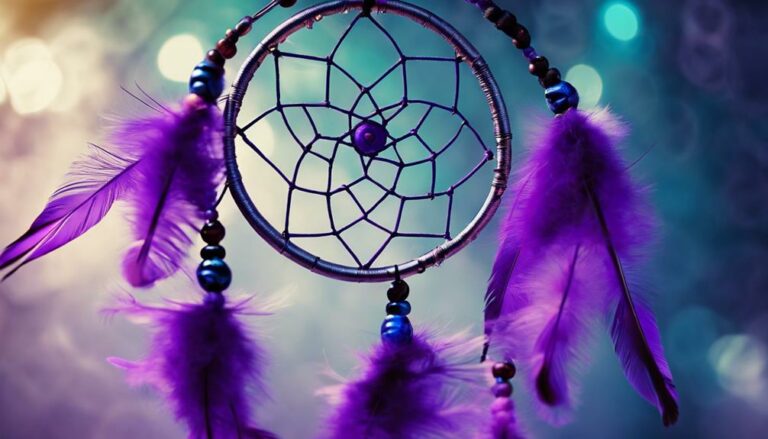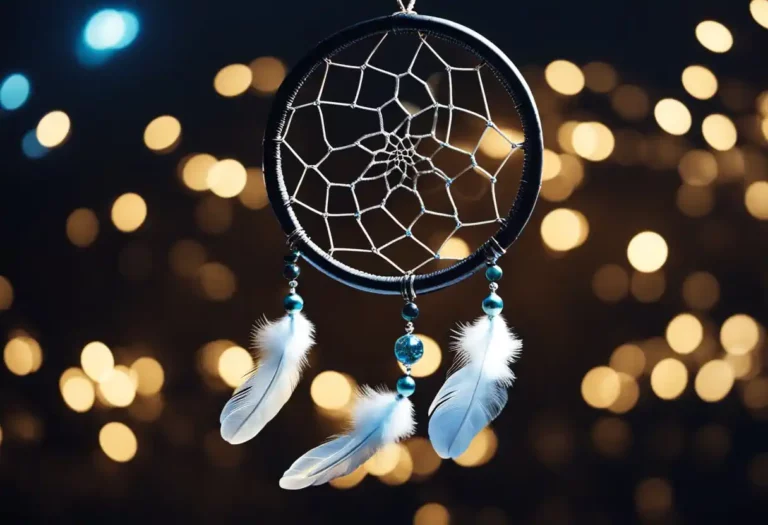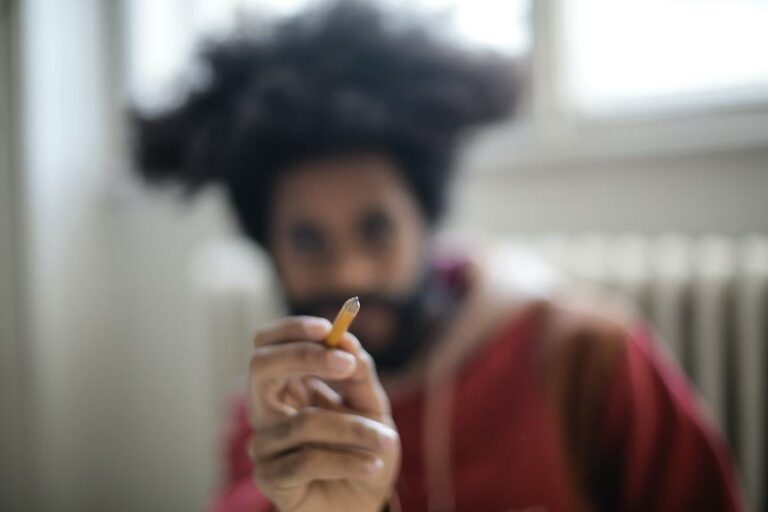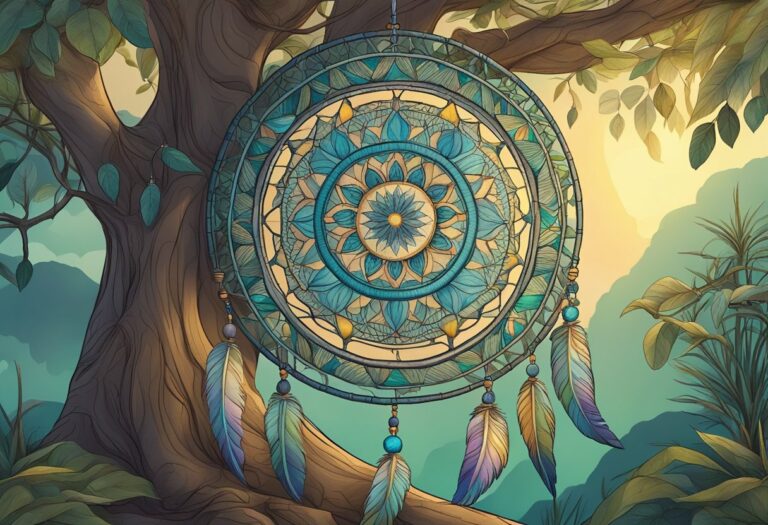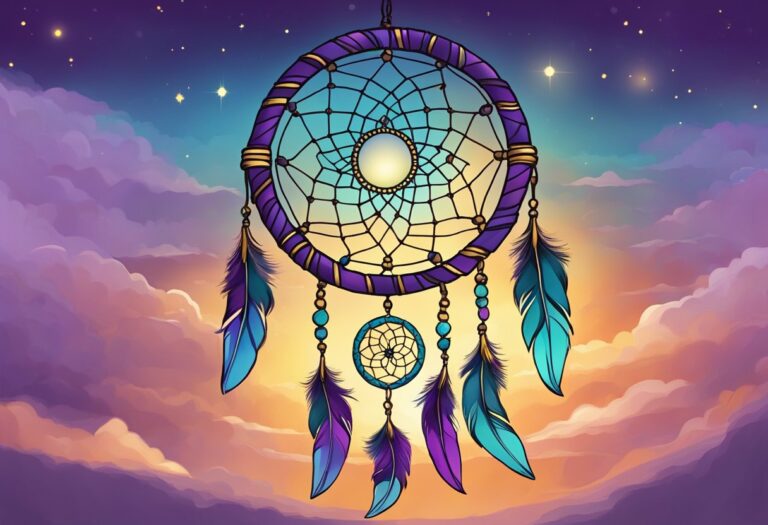Different Types of Dream Catchers and Their Meanings: A Comprehensive Guide
If you’ve ever been curious about dream catchers and their meanings, you’re in the right place. Dream catchers are popular Native American crafts that have become a symbol of spirituality and protection. These beautiful and intricate pieces are believed to catch bad dreams and let good dreams pass through.

The origins of dream catchers are rooted in Native American culture, but today, they are used by people all over the world. The traditional dream catcher consists of a hoop, a woven web, and feathers, but there are many variations of dream catchers that vary in size, shape, and materials used. Each type of dream catcher has its own unique symbolism and meaning, making them a fascinating subject to explore.
In this article, we’ll take a closer look at the different types of dream catchers and their meanings. We’ll explore the materials used, the colors and shapes, the significance of charms and stones, and the different types of dream catchers used in various cultures. By the end of this article, you’ll have a deeper understanding of dream catchers and their spiritual significance.
Yes, there are different types of dream catchers, each with its own unique meaning. The circular shape is the most traditional and represents the circle of life, while other shapes such as hearts and triangles have their own unique meanings. The size of a dream catcher can also affect its meaning, with larger dream catchers believed to be more powerful and smaller dream catchers more portable.
Origins of Dream Catchers
Dream catchers have a rich history and are an integral part of Native American culture, specifically the Ojibwe tribe. The Ojibwe people believe in a spider woman named Asibikaashi, who takes care of the children and the people of the land. According to legend, Asibikaashi would weave a web above the sleeping children to protect them from bad dreams and negative energy. The web would catch the bad dreams and allow the good dreams to pass through the hole in the center of the web and into the child’s mind. This is the origin of the dream catcher.
The dream catcher is made up of a hoop, typically made of willow, and a web woven inside the hoop. The web is often made from natural materials like sinew, thread, or yarn and is woven in a circular pattern. The hoop and web represent the circle of life, and the hole in the center of the web represents the passage of good dreams. The dream catcher is often decorated with feathers, beads, and other natural objects, each with its own symbolic meaning.
Over time, the dream catcher has become a popular symbol in many cultures, and its use has spread beyond the Ojibwe tribe. Today, dream catchers are often used as decorative objects, and many people believe that they have the power to protect against bad dreams and negative energy.
In summary, the dream catcher has its origins in the Ojibwe tribe and is an important part of Native American culture. It is believed to have the power to protect against bad dreams and negative energy, and its use has spread beyond the Ojibwe tribe to become a popular symbol in many cultures.
Symbolism and Meanings

Dream catchers are not just beautiful decorative items but also hold deep symbolic meaning. They are believed to have originated from the Ojibwe tribe and were used to protect people from bad dreams and negative energies. Here are some of the meanings associated with different types of dream catchers:
- Feather Dream Catchers: These dream catchers are decorated with feathers and are thought to represent breath and air. Feathers are also believed to bring healing energy to the dreamer. White feathers symbolize purity and innocence, while black feathers represent protection and strength. Feathers of other colors, such as red or blue, can have their own symbolic meanings as well.
- Beaded Dream Catchers: Beads are often used to decorate dream catchers and can represent different things depending on their color and placement. Red beads are associated with the root chakra and can represent grounding and stability. Yellow beads are associated with the solar plexus chakra and can represent personal power and self-confidence. Blue beads are associated with the throat chakra and can represent communication and self-expression.
- Tree of Life Dream Catchers: These dream catchers feature a tree of life design and are believed to represent unity and interconnectedness. The tree of life is a symbol of growth, strength, and renewal. It is also associated with hope and peace.
- Negative Dream Catchers: These dream catchers are designed to catch negative dreams and energies. They are often decorated with dark colors and symbols of protection, such as the evil eye or the pentagram. They are believed to protect the dreamer from evil spirits and negative energies.
- Positive Dream Catchers: These dream catchers are designed to catch positive dreams and energies. They are often decorated with bright colors and symbols of hope and positivity, such as the sun or the butterfly. They are believed to bring good luck and positive energy to the dreamer.
In addition to the specific meanings associated with different types of dream catchers, dream catchers in general are believed to represent protection, hope, and unity. They are thought to filter out negative dreams and energies, allowing only positive dreams to reach the dreamer. The spider web design of the dream catcher is believed to symbolize the interconnectedness of all things, while the hole in the center represents the passage of good dreams.
Materials Used in Dream Catchers

Dream catchers are made from a variety of materials, including natural and synthetic materials. The materials used will depend on the type of dream catcher, the intended use, and the personal preferences of the creator. Here are some of the most common materials used in dream catchers:
- Web: The web is usually made from a strong thread or string, such as sinew, which is woven into a circular or oval shape. The web is meant to catch and filter out negative dreams, allowing only positive dreams to pass through.
- Feathers: Feathers are often used to decorate dream catchers, and they are believed to symbolize the breath of life. Different types of feathers may be used, including owl, eagle, and hawk feathers.
- Hoop: The hoop is the foundation of the dream catcher and is usually made from a natural material, such as wood or willow. The hoop represents the circle of life and the continuity of the universe.
- Beads: Beads are often used to decorate dream catchers and may be made from a variety of materials, including wood, bone, and glass. Beads are believed to add energy to the dream catcher and may be used to symbolize different things, such as the sun or the moon.
- Leather: Leather is a common material used to wrap the hoop of the dream catcher. It is believed to represent the strength and durability of life.
- Natural Materials: Many dream catchers are made from natural materials, such as feathers, wood, and leather. These materials are believed to have special energy and may be used to enhance the power of the dream catcher.
- Threads: Threads are used to weave the web of the dream catcher and may be made from a variety of materials, including cotton, wool, and nylon. The color of the thread may be chosen to represent different things, such as the colors of the four directions.
In conclusion, dream catchers can be made from a variety of materials, each with its own symbolic meanings and purposes. Whether you choose to make your own dream catcher or purchase one, understanding the materials used can help you choose the perfect dream catcher for your needs and preferences.
Colors and Their Meanings

Dream catchers come in a variety of colors, each with its own unique symbolism and meaning. Here are some of the most common colors of dream catchers and their meanings:
- Red: A red dream catcher symbolizes energy, strength, and passion. It is believed to be a powerful tool for warding off negative energy and promoting positive energy.
- White: A white dream catcher represents purity, innocence, and clarity. It is often used to promote peaceful and restful sleep.
- Yellow: A yellow dream catcher symbolizes happiness, joy, and optimism. It is believed to bring positive energy and good luck to the dreamer.
- Blue: A blue dream catcher represents calmness, tranquility, and serenity. It is often used to promote relaxation and peaceful dreams.
- Black: A black dream catcher is believed to offer protection and ward off negative energy. It is often used to promote strength and courage.
- Brown: A brown dream catcher symbolizes stability, grounding, and connection to the earth. It is believed to promote feelings of security and safety.
- Green: A green dream catcher represents growth, renewal, and healing. It is often used to promote feelings of balance and harmony.
Each color used in a dream catcher has its own symbolism and can offer insights into its purpose and the dreams it is meant to capture and filter. From vibrant reds symbolizing passion and vitality to calming blues representing tranquility and peace, the colors woven into dream catchers provide a rich tapestry of symbolism that adds depth and meaning to these beautiful and powerful tools.
Shapes and Sizes
Dream catchers come in various shapes and sizes. The traditional dream catcher is circular, representing the circle of life. The circular shape is believed to symbolize the sun and the moon, which are integral parts of Native American culture. The circle also represents the cyclical nature of life, where everything is interconnected.
Apart from the traditional circular shape, dream catchers can come in other shapes such as hearts, triangles, and even animals. Each shape has its own significance and meaning. For instance, a heart-shaped dream catcher is believed to represent love and compassion, while a triangular dream catcher is believed to represent stability and balance.
The size of a dream catcher can also vary. Smaller dream catchers are often used as car decorations or hung on a doorknob, while larger dream catchers are used as wall hangings. The size of a dream catcher can also affect its meaning. A larger dream catcher is believed to have a more powerful protective effect, while a smaller dream catcher is believed to be more portable and easier to carry around.
In summary, dream catchers come in various shapes and sizes, each with its own significance and meaning. The circular shape is the most traditional and represents the circle of life, while other shapes such as hearts and triangles have their own unique meanings. The size of a dream catcher can also affect its meaning, with larger dream catchers believed to be more powerful and smaller dream catchers more portable.
Types of Dream Catchers
Dream catchers come in various shapes and sizes, each with its own unique meaning. Below are some of the most common types of dream catchers and their meanings.
Circular Dream Catcher
The circular dream catcher is the most traditional and well-known type of dream catcher. It features a circular hoop, often made of willow, with a woven web in the center and feathers and beads hanging from the bottom. The circular shape represents the circle of life, and the woven web is meant to catch bad dreams and allow good dreams to pass through. The feathers and beads are believed to provide protection and positive energy to the dreamer.
Spider Web Pattern Dream Catcher
The spider web pattern dream catcher is similar to the circular dream catcher, but instead of a solid woven web, it features a spider web pattern. This type of dream catcher is believed to be more effective at catching bad dreams, as the spider web pattern is thought to trap negative energy.
Mini Dream Catcher
The mini dream catcher is a modern version of the traditional dream catcher. It is smaller in size and often made with metal hoops and decorated with beads, feathers, and other items. The mini dream catcher is thought to be a symbol of protection and is believed to bring healing energy to the dreamer.
Dream Catcher for Kids
Dream catchers for kids often feature bright colors and playful designs, such as animals or cartoon characters. They are meant to be hung above a child’s bed to catch bad dreams and provide comfort and security. Dream catchers for kids can be made with a variety of materials, such as yarn, felt, or paper.
Overall, the type of dream catcher you choose depends on your personal preference and the meaning you want to convey. Whether you opt for a traditional circular dream catcher or a playful dream catcher for kids, each type is believed to provide protection and positive energy to the dreamer.
Significance of Charms and Stones
Dream catchers can be adorned with various charms and stones that hold significant meanings. These adornments are not only for aesthetic purposes but also for their spiritual and healing properties.
Charms such as feathers, arrowheads, and beads are often added to dream catchers to enhance their power. Feathers symbolize balance and connection to the spiritual realm, while arrowheads represent protection and strength. Beads, on the other hand, are believed to represent the spider’s web in the dream catcher, which catches bad dreams and allows good dreams to pass through.
Stones are also commonly used in dream catchers. Each gemstone has its own unique properties and is believed to have different effects on the dreamer. For example, amethyst is known for its calming and soothing properties, while rose quartz promotes love and healing.
It is important to note that the effectiveness of these charms and stones is subjective and varies from person to person. However, their presence in a dream catcher adds an extra layer of spiritual significance and meaning.
In summary, the significance of charms and stones in dream catchers cannot be overstated. These adornments hold spiritual and healing properties that can enhance the power of the dream catcher. Whether you choose to add feathers, arrowheads, beads, or gemstones, each addition brings its own unique meaning and significance to your dream catcher.
Dream Catchers in Various Cultures
Dream catchers have been used for centuries in various cultures around the world. In Native American culture, dream catchers were traditionally made by the Ojibwe people and later adopted by other tribes such as the Lakota tribe. The dream catcher was believed to filter out bad dreams and allow only good dreams to pass through. The bad dreams would be caught in the web of the dream catcher and burned away by the morning sun.
Dream catchers were also used in the pan-Indian movement, which aimed to unite various Native American tribes and promote their culture. Today, dream catchers are still popular in Native American culture and are often sold as souvenirs or decorative items.
In Asian cultures, dream catchers are also used as a way to ward off bad dreams. In Japan, dream catchers are known as “yume makura” or “dream pillows” and are believed to bring peaceful dreams to the sleeper. In Korea, dream catchers are called “joo-mong-so-ri” and are often given as gifts to children to protect them from nightmares.
Dream catchers are also used in Siberian shamanism, where they are believed to have protective and healing properties. The shaman would use the dream catcher to catch the bad dreams of their patients and then burn them away.
Overall, dream catchers have played an important role in many cultures around the world. They are believed to have protective properties and are often used as a way to ward off bad dreams. Whether you are Native American, Asian, or Siberian, dream catchers can be a meaningful and beautiful addition to your home or personal space.
Dream Catchers Today
Dream catchers have come a long way from their original purpose as talismans to keep away bad omens. Today, they are a popular decorative item and can be found in various forms such as car accessories, bed decorations, jewelry, souvenirs, and more.
If you’re looking for an authentic dream catcher, you can find them at Native American shops or online stores that specialize in Native American crafts. These dream catchers are usually hand-made using natural elements such as wood, leather, and feathers.
Dream catchers are also popular as car accessories. Many people hang dream catchers from their rearview mirror to add a unique touch to their car’s interior. Some car dream catchers are designed to be smaller and more compact, making them perfect for hanging in your car.
Dream catchers can also be used as a decorative item in your bedroom. You can hang a dream catcher above your bed to add a touch of bohemian style to your room. Some people believe that dream catchers can help you have more peaceful and restful sleep.
Finally, dream catchers are also popular as jewelry. You can find dream catcher necklaces, bracelets, and earrings in many stores. These pieces of jewelry are often adorned with feathers, beads, and other decorative elements.
Overall, dream catchers are a versatile and popular item that can add a unique touch to your life. Whether you’re looking for a talisman, a decorative item, or a piece of jewelry, there’s a dream catcher out there for you.
Conclusion
Dream catchers have a rich history and cultural significance, and they continue to be used today for various purposes. Whether you use them for healing, meditation, prayer, or simply as a decorative item, there is no denying the spiritual power they hold.
Different types of dream catchers have different meanings, and each one has its own unique purpose. Traditional Native American dream catchers are the most popular and are made using natural elements only. They are believed to protect individuals from bad dreams and negative energies by filtering out the bad and allowing only good energy to pass through.
Dream catchers with eagle feathers are believed to have divine power and are often used for spiritual purposes. Bear dream catchers are said to bring strength and courage, while owl dream catchers are believed to bring wisdom and insight. Buffalo dream catchers are thought to bring abundance and prosperity.
Spider dream catchers are particularly significant, as spiders are seen as symbols of wisdom and learning. Spider woman, a prominent figure in Native American mythology, is believed to have taught humans how to weave and create dream catchers. The intricate web of a spider dream catcher is said to represent the circle of life and the interconnectedness of all things in the universe.
Dream catchers can also be used to ease anxiety and ward off bad omens. They are often given as gifts to infants to protect them from negative energies and promote good dreams. No matter what your reason for using a dream catcher may be, there is no denying the beauty and spiritual significance of these intricate creations.
